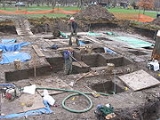
Iowa archaeology
Encyclopedia
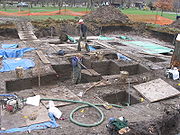
Archaeology
Archaeology, or archeology , is the study of human society, primarily through the recovery and analysis of the material culture and environmental data that they have left behind, which includes artifacts, architecture, biofacts and cultural landscapes...
of Iowa
Iowa
Iowa is a state located in the Midwestern United States, an area often referred to as the "American Heartland". It derives its name from the Ioway people, one of the many American Indian tribes that occupied the state at the time of European exploration. Iowa was a part of the French colony of New...
is the study of the buried remains of human
Human
Humans are the only living species in the Homo genus...
culture
Culture
Culture is a term that has many different inter-related meanings. For example, in 1952, Alfred Kroeber and Clyde Kluckhohn compiled a list of 164 definitions of "culture" in Culture: A Critical Review of Concepts and Definitions...
within the state of Iowa from the earliest prehistoric
Prehistory
Prehistory is the span of time before recorded history. Prehistory can refer to the period of human existence before the availability of those written records with which recorded history begins. More broadly, it refers to all the time preceding human existence and the invention of writing...
through the late historic
History
History is the discovery, collection, organization, and presentation of information about past events. History can also mean the period of time after writing was invented. Scholars who write about history are called historians...
periods. When the American Indians
Indigenous peoples of the Americas
The indigenous peoples of the Americas are the pre-Columbian inhabitants of North and South America, their descendants and other ethnic groups who are identified with those peoples. Indigenous peoples are known in Canada as Aboriginal peoples, and in the United States as Native Americans...
first arrived in what is now Iowa more than 13,000 years ago, they were hunters and gatherers
Hunter-gatherer
A hunter-gatherer or forage society is one in which most or all food is obtained from wild plants and animals, in contrast to agricultural societies which rely mainly on domesticated species. Hunting and gathering was the ancestral subsistence mode of Homo, and all modern humans were...
living in a Pleistocene
Pleistocene
The Pleistocene is the epoch from 2,588,000 to 11,700 years BP that spans the world's recent period of repeated glaciations. The name pleistocene is derived from the Greek and ....
glacial
Glacier
A glacier is a large persistent body of ice that forms where the accumulation of snow exceeds its ablation over many years, often centuries. At least 0.1 km² in area and 50 m thick, but often much larger, a glacier slowly deforms and flows due to stresses induced by its weight...
landscape. By the time European
Culture of Europe
The culture of Europe might better be described as a series of overlapping cultures. Whether it is a question of North as opposed to South; West as opposed to East; Orthodoxism as opposed to Protestantism as opposed to Catholicism as opposed to Secularism; many have claimed to identify cultural...
explorers visited Iowa, American Indians were largely settled farmers with complex economic, social, and political systems. This transformation happened gradually. During the Archaic period (10,500–2,800 years ago) American Indians adapted to local environments and ecosystems, slowly becoming more sedentary as populations increased. More than 3,000 years ago, during the Late Archaic period, American Indians in Iowa began utilizing domesticated
Domestication
Domestication or taming is the process whereby a population of animals or plants, through a process of selection, becomes accustomed to human provision and control. In the Convention on Biological Diversity a domesticated species is defined as a 'species in which the evolutionary process has been...
plants. The subsequent Woodland period
Woodland period
The Woodland period of North American pre-Columbian cultures was from roughly 1000 BCE to 1000 CE in the eastern part of North America. The term "Woodland Period" was introduced in the 1930s as a generic header for prehistoric sites falling between the Archaic hunter-gatherers and the...
saw an increase on the reliance on agriculture
Agriculture
Agriculture is the cultivation of animals, plants, fungi and other life forms for food, fiber, and other products used to sustain life. Agriculture was the key implement in the rise of sedentary human civilization, whereby farming of domesticated species created food surpluses that nurtured the...
and social complexity, with increased use of mounds, ceramics, and specialized subsistence. During the Late Prehistoric period (beginning about AD 900) increased use of maize
Maize
Maize known in many English-speaking countries as corn or mielie/mealie, is a grain domesticated by indigenous peoples in Mesoamerica in prehistoric times. The leafy stalk produces ears which contain seeds called kernels. Though technically a grain, maize kernels are used in cooking as a vegetable...
and social changes led to social flourishing and nucleated settlements. The arrival of European trade goods and diseases in the Protohistoric
Protohistory
Protohistory refers to a period between prehistory and history, during which a culture or civilization has not yet developed writing, but other cultures have already noted its existence in their own writings...
period led to dramatic population shifts and economic and social upheaval, with the arrival of new tribes and early European explorers and traders. During the Historical period European traders and American Indians in Iowa gave way to American settlers and Iowa was transformed into an agricultural state.
Iowa archaeologists
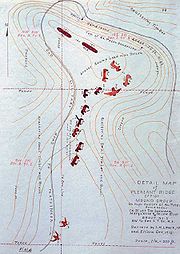
Charles R. Keyes
For the Iowa geologist, see Charles Rollin Keyes.Charles Reuben Keyes was a pioneering Iowa archaeologist, and linguist. He is best remembered as the founder of modern Iowa archaeology. While his early work dealt with lingusitcs, by the 1920s Keyes focused his research almost exclusively on...
and Ellison Orr’s surveys and excavations beginning in the 1920s. Documenting hundreds of sites, often just before they disappeared under the plow, Keyes’ and Orr’s work led to the formation of the Iowa Archaeological Survey, the Iowa Archeological Society, and the designation of Effigy Mounds National Monument
Effigy Mounds National Monument
Effigy Mounds National Monument preserves three prehistoric sites in Allamakee County and Clayton County, Iowa in the midwestern United States.-Mounds:...
. After their deaths in 1951, the Survey was disbanded, and their efforts were continued by the University of Iowa
University of Iowa
The University of Iowa is a public state-supported research university located in Iowa City, Iowa, United States. It is the oldest public university in the state. The university is organized into eleven colleges granting undergraduate, graduate, and professional degrees...
’s Department of Sociology and Anthropology, which formed the Office of the State Archaeologist (OSA) in 1959. The OSA maintains an extensive list of more than 23,000 recorded archaeological sites in Iowa, and conducts survey and excavation across the state. Other institutions conducting archaeological research in Iowa include the State Historical Society of Iowa
State Historical Society of Iowa
The State Historical Society of Iowa , a division of the , serves as the official historical repository for the State of Iowa and also provides grants, public education, and outreach about Iowa history and archaeology. The SHSI maintains a museum, library, archives, and research center in Des...
, the Iowa Archeological Society, the University of Iowa
University of Iowa
The University of Iowa is a public state-supported research university located in Iowa City, Iowa, United States. It is the oldest public university in the state. The university is organized into eleven colleges granting undergraduate, graduate, and professional degrees...
, Iowa State University
Iowa State University
Iowa State University of Science and Technology, more commonly known as Iowa State University , is a public land-grant and space-grant research university located in Ames, Iowa, United States. Iowa State has produced astronauts, scientists, and Nobel and Pulitzer Prize winners, along with a host of...
, Grinnell College
Grinnell College
Grinnell College is a private liberal arts college in Grinnell, Iowa, U.S. known for its strong tradition of social activism. It was founded in 1846, when a group of pioneer New England Congregationalists established the Trustees of Iowa College....
, Luther College
Luther College (Iowa)
Luther College is a four-year, residential liberal arts institution of the Evangelical Lutheran Church in America, located in Decorah, Iowa, USA...
, and private archaeological firms. Professional archaeologists in Iowa are represented by the Association of Iowa Archaeologists. Iowa archaeology grew dramatically beginning in the 1960s with the introduction of Cultural Resources Management
Cultural resources management
In the broadest sense, Cultural Resources Management is the vocation and practice of managing cultural resources, such as the arts and heritage. It incorporates Cultural Heritage Management which is concerned with traditional and historic culture. It also delves into the material culture of...
legislation that required archaeological survey and excavation at many federal projects in Iowa.
Paleoindian (13,500–10,500 years ago)
Paleoindian hunters and gatherers were the first occupants of Iowa, entering the state at the end of the PleistocenePleistocene
The Pleistocene is the epoch from 2,588,000 to 11,700 years BP that spans the world's recent period of repeated glaciations. The name pleistocene is derived from the Greek and ....
glacial period. At the time the state was covered by tundra, conifer forests, and deciduous forests. Areas immediately north of Des Moines extending to Minnesota were covered by the receding Des Moines Lobe, a large glacier system. Highly mobile, their sites are scattered across Iowa and are noted for their large stone points. While Paleoindians were traditionally viewed as big game hunters, more recent research suggests much of their subsistence was derived from small game and wild plants. Paleoindian points are found throughout Iowa, but almost no intact Paleoindian sites have been excavated, probably because they were ephemeral and are now either destroyed by plowing or are very deeply buried in river valleys.
Clovis and other Early Paleoindian
The oldest artifacts found in Iowa are ClovisClovis culture
The Clovis culture is a prehistoric Paleo-Indian culture that first appears 11,500 RCYBP , at the end of the last glacial period, characterized by the manufacture of "Clovis points" and distinctive bone and ivory tools...
points, large lanceolate points found occasionally in all parts of the state except for the Des Moines Lobe. Possible sources of game were giant Pleistocene megafauna, including mammoth, mastodon, and giant forms of bison, all of which are now extinct. While widespread, only two Clovis sites have been excavated in Iowa. The Rummells-Maske site is a Clovis site in Cedar County; unfortunately, this site was damaged by plowing, although 20 points and point fragments were recovered. The Carlisle Clovis Cache Site in Warren County contained 38 unfinished stone tools that appear to date to the Clovis period, but these results have not yet been published.
Other Iowa Early Paleoindian points include Gainey, a point that appears to be intermediate between Clovis and Folsom. Gainey points were also recovered at Rummells-Maske. While Folsom point
Folsom point
Folsom points are a distinct form of chipped stone projectile points associated with the Folsom Tradition of North America. The style of toolmaking was named after Folsom, New Mexico where the first sample was found within the bone structure of a bison in 1927....
s are found throughout Iowa, especially western Iowa, none have been excavated in a well-preserved site.
Dalton and other Late Paleoindian
At the beginning of the glacial-free HoloceneHolocene
The Holocene is a geological epoch which began at the end of the Pleistocene and continues to the present. The Holocene is part of the Quaternary period. Its name comes from the Greek words and , meaning "entirely recent"...
Epoch, humans in Iowa utilized projectile point found throughout the mid-continent, including Dalton, Fayette, Agate Basin, and Hell Gap
Hell Gap complex
Hell Gap complex is a Plano culture from 10,060 to 9,600 before present that is named after the archaeological site in Hell Gap, Wyoming. Hell Gap points are long stemmed, convex blades....
. Humans were still highly mobile, and by this time most of the Pleistocene megafauna had gone extinct. As with the Early Paleoindian period, no intact Late Paleoindian sites have been excavated in Iowa.
Archaic Period
The Archaic is the longest period of Iowa prehistory, lasting about 8,000 years. Overall, populations appear to have increased in Iowa during the Archaic, despite a changing climate. During this time American Indians transitioned from highly mobile hunters and gatherers with large ranges towards a focus on local resources and ecosystems. Domesticated plants appeared in Iowa towards the end of the Archaic.Early Archaic (10,500–7,500 years ago)
During the Early Archaic period regional variation in point forms is seen in Iowa, and Indians adapted to more localized forms of hunting and gathering while probably maintaining seasonal movements from camp to camp. Common stone tool types are Corner-notched St. Charles points and Thebes Knives. Soon Hardin and Kirk points appear in Iowa as well. Excavated Early Archaic sites in Iowa include the Soldow Site, Horizons IIIa and II of the Cherokee Sewer SiteCherokee Sewer Site
The Cherokee Sewer Site is a multi-component Prehistoric Indian Archaic bison processing site excavated in 1973 and 1976 near the sewage treatment plant of Cherokee, Iowa; it is not associated with the Cherokee tribe. It is important because it shows a transition in bison hunting strategy during...
, and the Simonsen Site.
Middle Archaic (7,500–5,000 years ago)
Temperatures rose in the mid-continent during the Middle Archaic, a warming trend known as the HypsithermalHolocene climatic optimum
The Holocene Climate Optimum was a warm period during roughly the interval 9,000 to 5,000 years B.P.. This event has also been known by many other names, including: Hypsithermal, Altithermal, Climatic Optimum, Holocene Optimum, Holocene Thermal Maximum, and Holocene Megathermal.This warm period...
. Grasslands expanded east, forests became less common, and many Iowa lakes shrank or disappeared. Humans responded by diversifying their subsistence strategy: eastern Iowa saw a shift towards river resources, and western Iowa towards Plains resources. Excavated sites in eastern and central Iowa include the Brash Site, the Gast Spring Site, and the Ed’s Meadow Site. Western Iowa sites include the Turin Site, Horizon I of the Cherokee Sewer Site
Cherokee Sewer Site
The Cherokee Sewer Site is a multi-component Prehistoric Indian Archaic bison processing site excavated in 1973 and 1976 near the sewage treatment plant of Cherokee, Iowa; it is not associated with the Cherokee tribe. It is important because it shows a transition in bison hunting strategy during...
, and the Pony Creek Site.
Late Archaic (5,000–2,800 years ago)
In the Late Archaic the climate became more similar to modern with the end of the HypsithermalHolocene climatic optimum
The Holocene Climate Optimum was a warm period during roughly the interval 9,000 to 5,000 years B.P.. This event has also been known by many other names, including: Hypsithermal, Altithermal, Climatic Optimum, Holocene Optimum, Holocene Thermal Maximum, and Holocene Megathermal.This warm period...
. The number of Late Archaic Sites increased in Iowa, perhaps reflective of increased populations allowed by climate change and new subsistence strategies. The Late Archaic sees the first indication of mound building in Iowa, as well as direct evidence of domesticated plants, and large, long-term settlements. The Red Ocher Culture
Red Ocher Culture
The Red Ocher people were an indigenous people of North America. A series of archaeological sites located in the Upper Great Lakes, the Greater Illinois River Valley, and the Ohio River Valley in the American Midwest have been discovered to be a Red Ocher burial complex, dating from 1000 BC to 400...
appeared in northeast Iowa, associated with copper artifacts and mound building. Numerous Late Archaic sites have been excavated in eastern Iowa, some showing the gradual adaptation of cultigen
Cultigen
A cultigen is a plant that has been deliberately altered or selected by humans; it is the result of artificial selection. These "man-made" or anthropogenic plants are, for the most part, plants of commerce that are used in horticulture, agriculture and forestry...
s, including squash, little barley
Hordeum pusillum
Hordeum pusillum or little barley is a diploid-type species of the Poaceae family of grasses. H. pusillum, native to the United States except the westernmost parts, originated via multiple long-distance dispersals of a southern South American species of Hordeum to North America about 1 million...
, marsh elder
Iva annua
Iva annua, sumpweed or marshelder, is an herbaceous annual plant native to much of North America.-Uses:Iva annua var. macrocarpa was formerly cultivated by Native Americans in the central eastern United States and specifically the indigenous peoples of the Kansas City Hopewell culture in present...
, and barnyard grass
Echinochloa
Echinochloa is a grass genus, some of whose members are millets grown as cereal or fodder crops. The most notable of these are Japanese Millet in East Asia, Indian barnyard Millet in South Asia and Burgu Millet in West Africa...
. Sites with evidence for early cultigens in Iowa include the Edgewater Park Site
Edgewater Park Site
The Edgewater Park Site is a 3,800-year-old Late Archaic campsite situated along the Iowa River in Coralville, Iowa, United States. Plant remains recovered from the site suggest the inhabitants were in the earliest stages of adapting domesticated plants....
in Coralville, the Gast Spring Site, and the Sand Run Slough West Site. In western Iowa, Late Archaic sites are common, however large bison killing or processing sites are less common than before, and there is little evidence for the use of domesticated plants.
Woodland Period

Ceramic art
In art history, ceramics and ceramic art mean art objects such as figures, tiles, and tableware made from clay and other raw materials by the process of pottery. Some ceramic products are regarded as fine art, while others are regarded as decorative, industrial or applied art objects, or as...
, the bow and arrow
Bow (weapon)
The bow and arrow is a projectile weapon system that predates recorded history and is common to most cultures.-Description:A bow is a flexible arc that shoots aerodynamic projectiles by means of elastic energy. Essentially, the bow is a form of spring powered by a string or cord...
, burial mounds
Mound
A mound is a general term for an artificial heaped pile of earth, gravel, sand, rocks, or debris. The most common use is in reference to natural earthen formation such as hills and mountains, particularly if they appear artificial. The term may also be applied to any rounded area of topographically...
, and evidence of political and social hierarchy became common at Woodland sites in Iowa.
Early Woodland (800 BC–200 BC)
The Early Woodland period saw the introduction of ceramics to Iowa, including Marion Thick and Black Sand types. Marion Thick may have originated with the nucleated Late Archaic cultures of the Upper Midwest, and was widespread in distribution. Early Woodland Indians in eastern Iowa built large burial mounds in the Mississippi River region, and participated in long-distance trade of exotic raw material. This long-distance trade may have been the forerunner of the later Havanna-Hopewell trading sphere. In north-central Iowa, Early Woodland peoples appear to have interacted more directly with the Prairie LakesPrairie lake
A prairie lake is a somewhat shallow lake that will empty naturally during dry periods allowing a variety of land plants to flourish in the rich nutrients on the lake bottom. The lakes eventually fill up with water returning to their previous state. In northern Florida, a Flatwoods/Prairie Lake is...
region of Minnesota
Minnesota
Minnesota is a U.S. state located in the Midwestern United States. The twelfth largest state of the U.S., it is the twenty-first most populous, with 5.3 million residents. Minnesota was carved out of the eastern half of the Minnesota Territory and admitted to the Union as the thirty-second state...
. Numerous Early Woodland sites have been excavated in Iowa, including the Gast Spring Site, and many sites which have not been formally published.
Middle Woodland (200 BC–400 AD)
The Middle Woodland Indians of eastern Iowa participated at the edge of the Havana and Hopewell interaction networks. This cultural connection to the East is seen in the construction of large mounds, earthworks, and the trade of exotic goods over very long distances. There were several large earthwork enclosures in Iowa along the Mississippi that date to the Middle Woodland period, but none in the interior of the state, indicating Iowa is the western edge of Havana-Hopewell influence. The Toolesboro Mound GroupToolesboro Mound Group
The Toolesboro Mound Group, a National Historic Landmark, is a group of Havana Hopewell culture earthworks on the north bank of the Iowa River near its discharge into the Mississippi. The mounds are owned and displayed to the public by the State Historical Society of Iowa...
in Louisa County included a large octagonal earthen enclosure that covered several acres; earthworks of this style are indicative of the monumental construction once seen in Havana, Illinois
Havana, Illinois
Havana is a city in Mason County, Illinois, United States. The population was 3,577 at the 2000 census, and 3,260 at a 2009 estimate. It is the county seat of Mason County.-Geography:...
along the Illinois River and sites in the Ohio River drainage including Chillicothe and Newark, Ohio. Hopewell trading networks were quite extensive, with obsidian
Obsidian
Obsidian is a naturally occurring volcanic glass formed as an extrusive igneous rock.It is produced when felsic lava extruded from a volcano cools rapidly with minimum crystal growth...
from the Yellowstone
Yellowstone National Park
Yellowstone National Park, established by the U.S. Congress and signed into law by President Ulysses S. Grant on March 1, 1872, is a national park located primarily in the U.S. state of Wyoming, although it also extends into Montana and Idaho...
area, copper
Copper
Copper is a chemical element with the symbol Cu and atomic number 29. It is a ductile metal with very high thermal and electrical conductivity. Pure copper is soft and malleable; an exposed surface has a reddish-orange tarnish...
from Lake Superior
Lake Superior
Lake Superior is the largest of the five traditionally-demarcated Great Lakes of North America. It is bounded to the north by the Canadian province of Ontario and the U.S. state of Minnesota, and to the south by the U.S. states of Wisconsin and Michigan. It is the largest freshwater lake in the...
, and shells from the Gulf Coast
Gulf Coast of the United States
The Gulf Coast of the United States, sometimes referred to as the Gulf South, South Coast, or 3rd Coast, comprises the coasts of American states that are on the Gulf of Mexico, which includes Texas, Louisiana, Mississippi, Alabama, and Florida and are known as the Gulf States...
appearing in Middle Woodland Iowa sites. Sites in eastern Iowa appeared to nucleate, vacating much of the hinterlands. Western Iowa appears to have been not directly involved in this exchange network, and the Havana-Hopewell flourishing did not extend much above the Kansas City
Kansas City, Missouri
Kansas City, Missouri is the largest city in the U.S. state of Missouri and is the anchor city of the Kansas City Metropolitan Area, the second largest metropolitan area in Missouri. It encompasses in parts of Jackson, Clay, Cass, and Platte counties...
area of the Missouri River
Missouri River
The Missouri River flows through the central United States, and is a tributary of the Mississippi River. It is the longest river in North America and drains the third largest area, though only the thirteenth largest by discharge. The Missouri's watershed encompasses most of the American Great...
.
Late Woodland (400–1250 AD)
The Late Woodland Period was once considered to be relatively unimportant and uninteresting compared to earlier and later periods, but recent research shows unexpected cultural complexity. Late Woodland sites are more dispersed than Middle Woodland sites, but they are apparently more numerous. Gone are the complex earthworks and long-distance trade networks, but this does not appear to be a cultural collapse, since Late Woodland sites and artifact types overlap with and transition from Middle Woodland sites. Technical changes of the Late Woodland include the use of true arrow heads, thinner and larger ceramics with less elaborate decorations, and the adaptation of new crops, including maizeMaize
Maize known in many English-speaking countries as corn or mielie/mealie, is a grain domesticated by indigenous peoples in Mesoamerica in prehistoric times. The leafy stalk produces ears which contain seeds called kernels. Though technically a grain, maize kernels are used in cooking as a vegetable...
. Numerous regional variations and phases have been defined in Iowa, based in large extent on differences of ceramic form and decoration. Excavations at Late Woodland sites are common, some of these sites showing surprising complexity. The Gast Farm Site excavations revealed a complex settlement associated with a midden of refuse 100 m in diameter. Large storage and food processing pits, trash middens, and other features were excavated. Occupants utilized acorns, other nuts and fruits, goosefoot, little barley, maygrass, sunflower, fish, birds, deer, muskrat, and turtle. There was little evidence of long-distance trade. The Rainbow and M.A.D. sites provide a glimpse into the Late Archaic of western Iowa. At Rainbow, a large house was excavated, showing evidence of reuse and possible joint occupation by two families. Mound building became more common during the Late Woodland Period, large groups of mounds appeared including the Slinde Mound Group
Slinde Mounds State Preserve
Slinde Mounds State Preserve contains ancient Indian mound burials in some hill prairie. About in extent, it is on a terrace above Canoe Creek, a tributary of the Upper Iowa River, and is approximately six miles from Waukon, Iowa in Hanover Township, in Allamakee County.The state acquired the land...
, and the Fish Farm Mound Group
Fish Farm Mounds State Preserve
Fish Farm Mounds State Preserve is a archaeological mound group containing Native American burials in Iowa. It is located within the larger Fish Farms Mounds Wildlife area, a state owned hunting area a few miles south of New Albin, just inland from the Upper Mississippi River in Allamakee...
.
Effigy Mounds
The Late Woodland in Iowa is perhaps best known for effigy mounds, large, low mounds shaped like animals such as birds and bears. Effigy mounds are distributed across southern WisconsinWisconsin
Wisconsin is a U.S. state located in the north-central United States and is part of the Midwest. It is bordered by Minnesota to the west, Iowa to the southwest, Illinois to the south, Lake Michigan to the east, Michigan to the northeast, and Lake Superior to the north. Wisconsin's capital is...
, northern Illinois
Illinois
Illinois is the fifth-most populous state of the United States of America, and is often noted for being a microcosm of the entire country. With Chicago in the northeast, small industrial cities and great agricultural productivity in central and northern Illinois, and natural resources like coal,...
, and northeast Iowa. A large concentration of mounds in several groups is preserved at Effigy Mounds National Monument
Effigy Mounds National Monument
Effigy Mounds National Monument preserves three prehistoric sites in Allamakee County and Clayton County, Iowa in the midwestern United States.-Mounds:...
. Like most mounds in Iowa, excavation reveals that these mounds were commonly used as sacred burial locations but contain few artifacts. Recent ground-penetrating radar survey of selected mounds at Effigy Mounds National Monument reveal that many are badly disturbed, but others appear to be comparatively intact. The Folkert Mound Group
Folkert Mound Group
The Folkert Mound Group of Hardin County, Iowa is a collection of 27 prehistoric mounds on the bluffs above the Iowa River, in a variety of shapes, including linear, compound, conical, and an enigmatic cruciform mound....
in central Iowa contains an enigmatic cruciform mound that may or may not be astronomically aligned.
Late Prehistoric (900–1600)
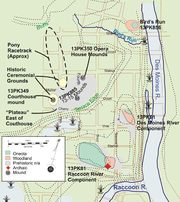
Maize
Maize known in many English-speaking countries as corn or mielie/mealie, is a grain domesticated by indigenous peoples in Mesoamerica in prehistoric times. The leafy stalk produces ears which contain seeds called kernels. Though technically a grain, maize kernels are used in cooking as a vegetable...
appears to have been the catalyst for change in the Late Prehistoric period in Iowa. While maize had been a minor crop in the Woodland Period, many archaeologists believe new varieties of maize were introduced to the region that produced higher yields, allowing for a population boom. This increase in population, combined with the potential for surplus and growing tensions over control of territory, appears to have led to large nucleated settlements throughout the eastern U.S. Although this manifested itself earliest along the Mississippi south of Iowa, the earliest Late Prehistoric cultures appeared in the western part of the state.
Great Oasis (ca. 900–1100)
Great Oasis sites appeared in the Missouri River drainage, and have attributes of both Late Woodland and Late Prehistoric cultures. Great Oasis cultures extended through the eastern Plains from Iowa to South Dakota. Developing independently from the eastern Mississippian cultures, Great Oasis sites display large sites along major stream terraces, increased reliance on agriculture combined with hunting and gathering, substantial pit earth lodges, and a transition from Late Woodland to Late Prehistoric ceramic forms. Overall, Great Oasis appears to have been a regional adaptation of new forms of farming and settlement patterns, including seasonal occupation of different ecological zones, that includes aspects of Late Woodland and the subsequent Middle Missouri Tradition.Mill Creek and Glenwood (1100–1300)
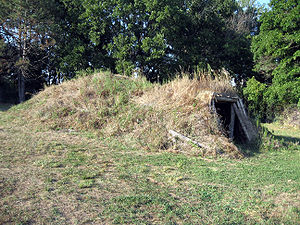
Maize
Maize known in many English-speaking countries as corn or mielie/mealie, is a grain domesticated by indigenous peoples in Mesoamerica in prehistoric times. The leafy stalk produces ears which contain seeds called kernels. Though technically a grain, maize kernels are used in cooking as a vegetable...
and bison hunting, show substantial evidence of long-distance trade, and appear to have been occupied year-round. The Phipps
Phipps Site
The Phipps Site is a Late Prehistoric Mill Creek Culture archaeological site near Cherokee in Cherokee County, Iowa, United States....
and Chan-Ya-Ta
Chan-Ya-Ta Site
The Chan-Ya-Ta Site is a Late Prehistoric village in Buena Vista County, Iowa in which Native Americans lived in large earthlodge structures surrounded by a fortified ditch....
sites are classic examples. Glenwood culture
Glenwood culture
The Glenwood Culture was a population of Indigenous peoples of North America prior to historical times. The culture is recognized as an eastern extension of the Nebraska Phase of the Woodland period, and were not a Mississippian culture.- Culture :...
sites in southwest Iowa near the Missouri River appear to be unrelated to the earlier Great Oasis sites, and are notable for their large earthlodge sites. Glenwood sites appear to have been more oriented in lifeways and trade with the Central Plains Tradition cultures to the west than with the Mississippian cultures to the southeast. Around 1300 AD Mill Creek and Glenwood sites in Iowa disappeared, replaced by the rapidly spreading Oneota cultures.
Oneota (1250–1700)
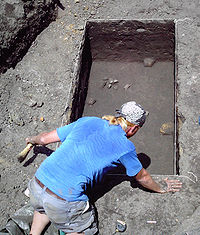
Palisade
A palisade is a steel or wooden fence or wall of variable height, usually used as a defensive structure.- Typical construction :Typical construction consisted of small or mid sized tree trunks aligned vertically, with no spacing in between. The trunks were sharpened or pointed at the top, and were...
s, and extreme social hierarchy. The earliest large Mississippian center was Cahokia
Cahokia
Cahokia Mounds State Historic Site is the area of an ancient indigenous city located in the American Bottom floodplain, between East Saint Louis and Collinsville in south-western Illinois, across the Mississippi River from St. Louis, Missouri. The site included 120 human-built earthwork mounds...
, east of St. Louis. Cahokia appears to have dominated trade in the upper Mississippi, with satellite or closely aligned settlements as far as Aztalan
Aztalan State Park
Aztalan State Park is a Wisconsin state park located just south of the town of Aztalan, Wisconsin at latitude N 43° 4' and longitude W 88° 52', and established in 1952. It was also designated a National Historic Landmark in 1964 and added to the National Register of Historic Places in 1966...
in Wisconsin. In Iowa, there is little evidence of Mississippian occupation, and the Late Woodland lasts longer in the east than in the west. This is puzzling, given the proximity to Mississippian cultures; it is possible that the nearby presence of the large, hierarchal Mississippian trading network inhibited local development. After the decline of the Cahokia network after AD 1250 the local Late Woodland
Woodland period
The Woodland period of North American pre-Columbian cultures was from roughly 1000 BCE to 1000 CE in the eastern part of North America. The term "Woodland Period" was introduced in the 1930s as a generic header for prehistoric sites falling between the Archaic hunter-gatherers and the...
populations expanded in complexity, developing large nucleated villages and their own trading network, known as Oneota
Oneota
Oneota is a designation archaeologists use to refer to a cultural complex that existed in the eastern plains and Great Lakes area of what is now the United States from around AD 900 to around 1650 or 1700. The culture is believed to have transitioned into various Macro-Siouan cultures of the...
. Oneota, named by Charles Keyes for a river in northeast Iowa
Upper Iowa River
The Upper Iowa River is a tributary of the Mississippi River in the upper Midwest of the United States.Its headwaters are in southeastern Minnesota, in Mower County near the border with Iowa. It then flows through the Iowa counties of Howard, Winneshiek, and Allamakee, and finally into the Upper...
, was a large cultural manifestation that covered the Upper Midwest at the edge of the Mississippian cultures. Oneota sites are easily identifiable by the globular, shell tempered pots, which typically have strap handles and incised designs. Pots of this kind were well designed for the cooking of porridge and foods made from the various cultivated foods of the area. Important Oneota sites in Iowa include Kingston, Mckinney, Christenson, Blood Run
Blood Run Site
The Blood Run Site is an archaeological site on the border of the US states of Iowa and South Dakota. The site was essentially populated for 8,500 years, within which earthworks structures were built by the Oneota Culture and occupied descendant tribes such as the Ioway, Otoe, Missouri, and shared...
, Hartley Fort
Hartley Fort State Preserve
Hartley Fort State Preserve is a Iowa state preserve located on the Upper Iowa River in the Driftless Area, in Allamakee County of Iowa.-Geography:...
, the Lane Enclosure, three sites in downtown Des Moines, and sites along the Upper Iowa River, including several large earthwork enclosures. After the decline of the Mill Creek and Glenwood cultures in western Iowa, Oneota cultures appeared across the state. It is widely accepted that the Oneota were the ancestors of modern American Indian tribes associated with Iowa, including the Ioway, Ho-Chunk
Ho-Chunk
The Ho-Chunk, also known as Winnebago, are a tribe of Native Americans, native to what is now Wisconsin and Illinois. There are two federally recognized Ho-Chunk tribes, the Ho-Chunk Nation of Wisconsin and Winnebago Tribe of Nebraska....
(Winnebago), Otoe
Otoe tribe
The Otoe or Oto are a Native American people. The Otoe language, Chiwere, is part of the Siouan family and closely related to that of the related Iowa and Missouri tribes.-History:...
, Missouria, and Omaha
Omaha (tribe)
The Omaha are a federally recognized Native American nation which lives on the Omaha Reservation in northeastern Nebraska and western Iowa, United States...
.
Protohistoric (1600–1800)

Jacques Marquette
Father Jacques Marquette S.J. , sometimes known as Père Marquette, was a French Jesuit missionary who founded Michigan's first European settlement, Sault Ste. Marie, and later founded St. Ignace, Michigan...
and Joliet occasionally documented American Indians along the Mississippi in Iowa, but it was not until the early 19th century that regular written accounts of American Indians in Iowa became common. American Indians in the early Protohistoric period continued many aspects of Oneota culture, but soon almost all indigenous technology disappeared, including ceramics and stone tool production. It was during this period that the Meskwaki
Meskwaki
The Meskwaki are a Native American people often known to outsiders as the Fox tribe. They have often been closely linked to the Sauk people. In their own language, the Meskwaki call themselves Meshkwahkihaki, which means "the Red-Earths." Historically their homelands were in the Great Lakes region...
(Fox) and Sauk appeared in eastern Iowa, displaced from their homelands in the east. Important protohistoric sites include Milford; Blood Run
Blood Run Site
The Blood Run Site is an archaeological site on the border of the US states of Iowa and South Dakota. The site was essentially populated for 8,500 years, within which earthworks structures were built by the Oneota Culture and occupied descendant tribes such as the Ioway, Otoe, Missouri, and shared...
; Gillett Grove; and Iowaville.
Historical (1800–present)
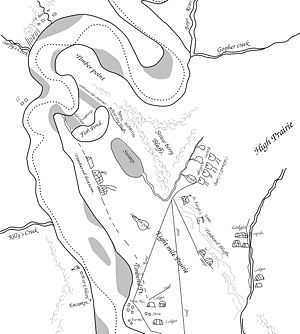
Julien Dubuque
Julien Dubuque was a French Canadian from the area of Champlain, Quebec who arrived near what now is known as Dubuque, Iowa - which was named after him. He was one of the first men to settle in the area. He initially received permission from the Meskwaki Native American tribe to mine the lead in...
’s Mines of Spain settlement and adjacent Meskwaki village occupied in the late 18th century and early 19th century, has been the subject of numerous archaeological surveys. Fort Madison (1808–1813), the first American settlement and the first American fort in Iowa, was partially excavated in 1965. American settlement began in earnest in the 1830s, and the official removal of American Indians from Iowa was completed by 1852. Several of these historical sites have been excavated, including Gilbert’s Trading Post. and Fort Atkinson. Archaeologists have also studied historical American settlements, including excavations at the Plum Grove Historic House
Plum Grove Historic House
Plum Grove is a historic house located in Iowa City, United States. Plum Grove was the retirement home of Gov. Robert Lucas and the childhood home of the author Eleanor Hoyt Brainerd. Built in 1844, Lucas lived there with his wife, Friendly, and several children and grandchildren...
, the Buxton African-American community, and the Bowen’s Prairie community.
See also
- Iowa Archaeological SocietyIowa Archaeological SocietyThe Iowa Archeological Society is an organization of amateur, professional, and academic archaeologists. The IAS promotes education about Iowa’s past, conducts excavations, and encourages ethical collection and recording of archaeological sites...
- Indians of IowaIndians of IowaIndians of Iowa include numerous Native American tribes which have lived in the state of Iowa historically and prehistorically:-Chewerean-Siouan speaking tribes from the prehistoric period:*Ho-Chunk...
- Geology of Iowa
- History of IowaHistory of IowaAlthough Native Americans have occupied what is now Iowa for 13,000 years, the written history of Iowa begins with the protohistoric accounts of Native Americans by explorers such as Marquette and Joliet in the 1680s. Until the early 19th century Iowa was occupied exclusively by Indians and a few...
- State Historical Society of IowaState Historical Society of IowaThe State Historical Society of Iowa , a division of the , serves as the official historical repository for the State of Iowa and also provides grants, public education, and outreach about Iowa history and archaeology. The SHSI maintains a museum, library, archives, and research center in Des...
- Iowa Historic Preservation AllianceIowa Historic Preservation AlliancePreservation Iowa, formerly called the Iowa Historic Preservation Alliance , was founded in 1989 by members of the public concerned about the destruction of significant historic sites and buildings in the state of Iowa....
- Effigy Mounds National MonumentEffigy Mounds National MonumentEffigy Mounds National Monument preserves three prehistoric sites in Allamakee County and Clayton County, Iowa in the midwestern United States.-Mounds:...
External links
- Iowa Office of the State Archaeologist Website
- Iowa Archaeological Society Website
- The Crops of Ancient Iowa
- State Historical Society of Iowa Archaeological Website
- Association of Iowa Archaeologists Website
- Department of Anthropology, University of Iowa Website
- Department of Anthropology, Iowa State University Website
- Department of Anthropology, Grinnell College Website
- Department of Anthropology, Luther College Website

